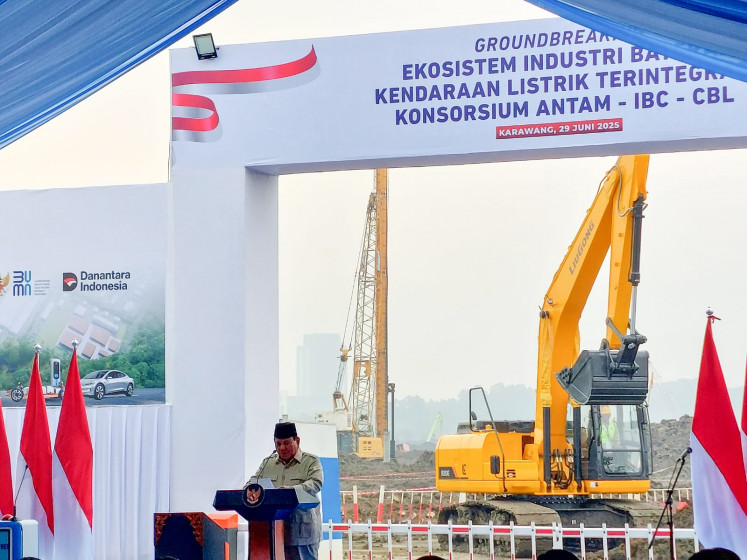Popular Reads
Top Results
Can't find what you're looking for?
View all search resultsPopular Reads
Top Results
Can't find what you're looking for?
View all search resultsInsight: Why the next president should pursue inclusive growth
Whoever gets elected Indonesian president in July, he faces the task of preventing Indonesian economic growth from slowing further
Change text size
Gift Premium Articles
to Anyone

W
hoever gets elected Indonesian president in July, he faces the task of preventing Indonesian economic growth from slowing further.
More importantly, he must ensure that economic growth during his term is more inclusive so that its benefits are shared more equally among Indonesians. The task of achieving more income equality is critical, since the income gap between rich and poor in Indonesia has grown wider in the last decade. The widening income gap between different groups could create undesirable social and political ramifications if it goes unchecked.
Greater inequality may lead to a political backlash where pressure on the government to enact populist policies could grow. This may be beneficial for the lower income group in the short term, but in the long term it could hold up efficiency and growth. Under such circumstances, our next president should be firm enough to prevent the interests of the political system diverging from the interests of the economy.
Income inequality is not just an expression of statistics, which fail to capture the human dimension of inequality in terms of human costs and the low quality of life suffered by lower income groups.
While the rich can indulge in luxurious consumption and comfortable living, the poor can barely make ends meet. They are denied access to decent public services such as schools, health services and sanitation. Income inequality in most cases means inequality of opportunity to get access to a higher social stratum. This means children are predestined to live at the same level as their parents.
The income inequality of a country is measured by the Gini index, a measure of income concentration that ranges between 0 and 100 (with 0 representing perfect equality and 100 representing a situation where all incomes flow to a single person). The higher the Gini index, the more unequal the distribution of income.
During the 1990s, the Gini index for Indonesia was 29.2, but according to the World Bank, in 2010 the index rose to 35.8 and again to 38.1 in 2011. This showed that despite rapid economic growth and increasing prosperity during the last decade, income inequality in Indonesia has worsened. The share of the highest 20 percent of income earners rose from 43.1 to 46 percent, while that of the lowest 20 percent dropped from 7.6 to 7.3 percent over the same period. The gap will continue to widen if the appropriate policies are not undertaken.
Conventional wisdom in economics holds that income equality manifests itself once gross domestic product (GDP) has reached a certain level. As the economy grows, more and more people will be employed and have a higher income. Those who are poor will be less poor, and if they are fortunate enough, their lot will be lifted above the poverty line.
This is what has happened, as during the last two decades the poverty level in Indonesia has fallen by half. But this does not solve the income gap problem, as the income and wealth of the rich is growing much faster than that of the poor.
A country can narrow the income gap by employing a wide array of policies, but whatever policies are to be adopted, it should lead to more effective use of the distributional mechanism, through taxation policies, transfers and better access to public services, especially for lower income groups
On March 1, The Economist presented a Gini index of several countries based on market income and net income values (after tax and transfer). According to this index, the US Gini index at market value was 46, but after the redistribution measures (tax and transfers), the Gini index went down to 36.
European countries have fared much better than the US, because their redistribution measures have reduced the gap between market-based and net value-based indexes more considerably than the US. Denmark showed its redistribution measures had cut the Gini index from 55 at the market income level to 25 at the net income level.
What about Indonesia? The chart showed the Indonesian Gini index at the market income level was 39, while at the net income level it was 38. The difference was little, meaning that measures of income redistribution in Indonesia had so far not produced any meaningful results. The failure of distributional policies in Indonesia explains why income inequality in Indonesia remains stubbornly high.
Several factors have contributed to rising inequality. Globalization has been often cited as a major contributor to increasing income concentration everywhere. In the past couple of decades, innovations, especially in the form of the Internet, have moved faster than we have been able to educate ourselves about them so that they can be applied.
The shortfall in the supply of advanced skills relative to the demand for them is pressing the salaries of skilled workers higher relative to the wages of the less skilled. As globalization increases the wage premium, technological innovation also takes a toll on lesser skilled workers. The demand for moderately skilled workers has declined as repetitive jobs have been gradually displaced by computer programs.
In the labor market structure of Indonesia, a large part of the labor force is employed in the informal sector, where low productivity and low wages have reinforced income inequality because the earnings of this group has grown slowly, or even remained stagnant. This gap is also reflected in the slow growth of consumption per capita of low income earners. Between 2003-2011, according to the World Bank, while the consumption per capita of the richest 20 percent grew by 5.2 percent per annum, the growth of consumption per capita of the poorest 40 percent was only 1.3 percent per annum.
This situation cannot be allowed to continue. The next Indonesian president should realize that the quality of economic growth matters as much as the rate of economic growth. He has to improve the quality of growth through improving the distribution of opportunities, sustaining natural capital, dealing with the global financial crisis (which in the past has caused increases in poverty and income gap) and improving governance and combating corruption.
In short he should realize that economic growth is not an end in itself, but is merely a means to improve the quality of life of Indonesians.
The writer is an economist.









